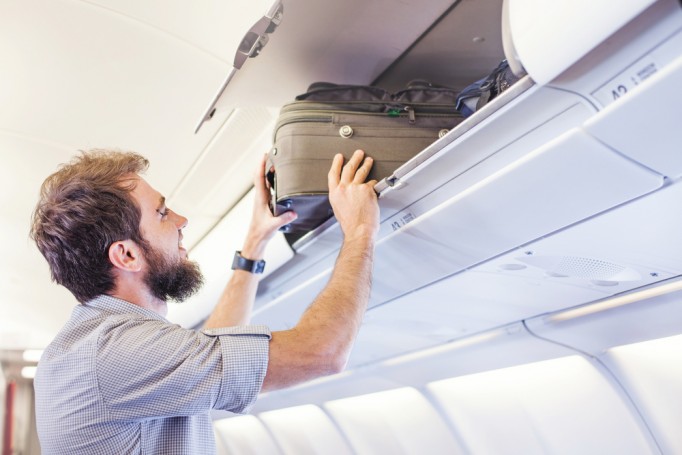One of the traveller’s concerns when travelling is the possibility of encountering problems when bringing their hand luggage onto the plane. Most prefer to avoid having to check their luggage, especially on trips of a few days that require only a small suitcase, for fear of losing their suitcase.
When we talk about the regulations applied by the airlines in relation to hand luggage, we find that the regulations seem to be increasingly strict and disparate. To this, we will add the setbacks that you could find yourself at the airport control itself.
Next, we give you the keys to avoid any type of problem and make sure when travelling with your hand luggage on the plane.
Table of Contents
Hand luggage: size and measurements
Something that brings us to mind is the rules regarding the measurements of the suitcase and weight. Our first recommendation is that you inform yourself of the regulations established by the airline with which you are going to travel since they vary from one to another. Although they all have rules in common, each one is different, and there are specific aspects that you will be interested in knowing in each case.
E n sometimes the rules change within a single airline depending on your rate. For example, does your ticket allow you to travel with hand luggage? Because many companies are beginning to charge this service separately. However, by choosing the right size and type of suitcase beforehand, you can avoid many complexities. For example, you can select a 55x40x20 cm cabin bag, which is widely accepted by many airlines. Adhering to this standard ensures a seamless experience for travellers, allowing them to navigate the check-in process with ease and avoid any unpleasant surprises.
Another example: can you get on the plane with extra bags, apart from hand luggage (a bag for example, or a small backpack)?
However, it is important to bear in mind that the airline can take your hand luggage to the hold if the space in the compartments is insufficient. How can you avoid it? Paying extra to get priority boarding or just being the first in line to board, go to the airport early.
If you are travelling with a baby, you can carry an additional bag with your things.
What type of liquids can I transport and how?
To understand this section, it is important to know what is considered liquid: water or any other drink; all kinds of lotions or creams, toothpaste, and oils; perfumes and colognes; shower gel or shampoo; shaving foam; roll-on deodorants; cream makeup; aerosols (hairspray, deodorant …); liquid or creamy foods: soups, syrups, jams, pâtés, sauces, and spreads.
When passing the control at the airport, we must ensure that the liquids travel in individual containers with capacities that do not exceed (each) 100 ml. In addition, they must all go together in a transparent bag or toiletry bag with a capacity of less than 1 litre, placed so that the authorities can quickly see what it is. Once at the control, you must remove this bag or toiletry bag from the suitcase to pass it through the control.
As in everything, there are exceptions: if you buy something at the airport’s Duty-Free, after control, you can put it on the plane. If you are travelling with a baby, you can get on the plane with their water, purees, milk or a bottle, etc. in a separate bag. If you need to travel with syrup-type medicines, you will not have a problem either, but bear in mind that they may ask for proof (prescription, medical report) that shows that you will need this medicine during the flight.
Can I bring food and drinks on the plane?
There is no problem if you travel between countries of the European Union, as long as they are not considered liquids such as soups, purees or cream cheese. Yes, you can get food on the plane even if it is liquid if you travel with a baby or your health requires a special diet. But always justifying the use of said foods. You can also get on the plane with food or drink that you have bought at the Duty-Free after the control, as long as everything is properly sealed. And be careful with Duty-Free alcoholic beverages: you can get on the plane with them, but without exceeding a certain limit, depending on the destination.
If you are not travelling between countries of the European Union, check the regulations of both the country of origin and that of destination to avoid problems.
What if I need to travel with medication?
Regarding the entry of medicines into the destination, the most important thing is to inform yourself of the regulations regarding medicines in the country you are travelling to.
With regard to cabin transport, you can bring medications onboard, in fact, it is recommended to travel with a basic travel kit and have it on hand in your carry-on luggage to be able to take it easy if needed. Of course, each medicine in its box with its leaflet.
Yes, they could be stricter with liquid medications, but you will not have problems if their use is justified, and you can present the medical report and/or the prescription that demonstrates the need to travel with said medication. These liquid medications, even exceeding 100 ml, must go in the bag with the rest of the liquids.
For the rest, find out about the regulations of the airline with which you fly for specific cases such as the transport of syringes, blood pressure monitors, or needles. And also take into account the type of medicine you are travelling with, as there are some that are spoiled by changes in temperature and pressure, such as insulin, which would force the traveller to travel with it in the cabin, instead of leaving it. in the warehouse.
Can I bring electronic devices on the plane?
You can get on the plane with your Smartphone, laptop, tablet, video camera … as long as you keep them with aeroplane mode activated. However, keep in mind that if the airline in question does not allow additional bags, you will have to store everything in your cabin bag. That is, if your airline does not provide additional packages, you will have to put the laptop bag inside your hand luggage.
What objects are prohibited on the plane?
Finally, keep in mind that there are a number of objects that you cannot get on the plane: sharp or sharp objects, sports equipment, tools, sports equipment, explosive or flammable weapons or materials, toxic substances such as insecticides, etc. This section is common to all airlines.
Here is an infographic that summarizes what can and cannot be carried in the cabin of the plane, according to everything discussed so far:
What if I need to bring a musical instrument or sports equipment with me?
Both sports equipment and musical instruments are considered by airlines as special luggage. Therefore, you can take your musical instrument or your sports equipment in the cabin as long as they are within the allowed objects and they respect the weight and size regulations. Otherwise, you will have to invoice it.
Find out about the regulations established by the airline with which you are going to travel. Not only to know if it is allowed and how, but to know how you should pack the object in question. Some companies allow you to get on board with an instrument as long as you buy a ticket for a separate seat where you can leave it.
















